
Bomb, Fall 2000, Editor's Choice
Citysearch, February 19, 2003
CultureFinder.com, July 24, 2000
New York Blade News, July 14, 2000
Playbill, July 18, 2000
The Tribeca Trib, February, 2003
Poughkeepsie Journal, June 12, 2000
Poughkeepsie Journal, June 6, 1997
Time Out New York, June 19-26, 1997
Woodstock Times, June 15, 2000
Citysearch, February 19, 2003
CultureFinder.com, July 24, 2000
New York Blade News, July 14, 2000
Playbill, July 18, 2000
The Tribeca Trib, February, 2003
Poughkeepsie Journal, June 12, 2000
Poughkeepsie Journal, June 6, 1997
Time Out New York, June 19-26, 1997
Woodstock Times, June 15, 2000
Dixie Sheridan: A Theater of Dreams
Carole MasoBomb Magazine
Editor's Choice: Art and Film
Fall 2000 (No. 73)

These scenarios, having lost their coordinates, are allowed to exist in a kind of staged-for-no-one space where they have a fresh, gently surrealist existence. An image of a glowing red purse positioned on a troubled human landscape has replayed again and again in my mind since I saw the show: a broken-off piece of the world's strangely moving detritus, sending its gorgeous, unreadable signal.
A peculiar magic is at work here. Instants of human existence float before us: a man, a chair, a bench, two shadows, an exit sign. Stairs leading we know not where, the siren of a red dress, a dancer dancing in eternal darkness, surrounded by the off-kilter, disconcerting space Sheridan's eye arranges again and again. At once passionate and dispassionate, logical and deranged, she photographs from the depths of her psyche with wonder and aplomb.
I come away from Sheridan's photos seeing the world a little differently: the danger and vulnerability of its objects, the quality of its darkness, the space that keeps collecting above my head. Through this work I come to be reminded of the world's obdurate resistance to reduction or simplification, its enigmatic refusal to decode our most urgent messages or answer our most pressing questions, its terrible and strange radiance. This is the truth upon which Sheridan's seductive and fierce photographs insist.
Sheridan's photographs were recently on view at 55 Mercer Gallery.
Dixie Sheridan: Works in Color
CitysearchVisual Arts Event Information
Event Mediums
Photography
February 19, 2003
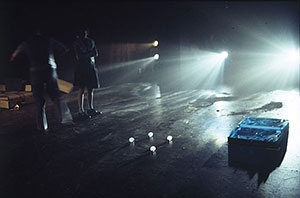
Lady Shutterbugs
Women have a long history of artfully documenting performing artists in action. Annie Leibowitz takes definitive Hollywood portraits; Lois Greenfield, eye-catching dance snapshots. Today's Broadway productions are often photographed by Joan Marcus and Carol Rosegg, while Anja Hitzenberger and Dona Ann McAdams make sure the avant garde gets its pictorial due. This exhibit of Sheridan, the resident photographer of the New York International Fringe Festival, makes a good case that another woman is ready to join the illustrious ranks.
Seeing Is Believing
You'll have to ignore the organic environmental clutter that comes with Amedee's framing shop to fully appreciate Sheridan's images. But if you can let the inadvertent distractions go, you're bound to appreciate how sunshine yellows and aquatic blues invest her dramatic stills with invigorating moods. The strongest image, a black-and-white circa 1999, reveals two nude women lying supine on the bar at Joe's Pub. Cheers, indeed.
The Off-Broadway Scout
David Cote & Michael GardnerCulturefinder.com
July 24, 2000
SNEAK PREVIEW
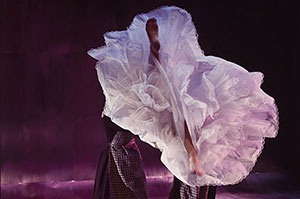
The honey-voiced Oklahoma native, who has been a journalist and the vice president for college relations at Vassar College (her undergraduate alma mater), earned her M.A. in theater history and criticism at the University of Oklahoma. After years as a reporter and editor, Sheridan came to Vassar and produced the college's Powerhouse Summer Theater program. When Powerhouse needed a photographer, Sheridan was more than happy to put "together two great passions. Eventually I decided to quit my wonderful job at Vassar... [and] come to NYC a freelance theater photographer." Sheridan has worked with some of New York's more exciting Off-Broadway and avant-garde groups, including Classic Stage Company (official photographer), Axis Theater, Collision Theory and the Ontological-Hysteric Theater . This August she'll be the official photographer for the New York International Fringe Festival. "My personal taste in theater," Sheridan says, "runs to Off and Off-Off Broadway. Non-traditional, experimental, visually alluring theater."
Although she is being exhibited at the Mercer gallery as an artist, Sheridan admits that paid gigs for theater are her bread and butter. "When I'm hired, they obviously need photos that follow certain conventions, for newspapers, publication – so it's a more journalistic approach," she said. Sheridan explains that one of the more challenging aspects of photographing theater is choosing that perfect promotional print. "You end up with an awful lot of people rejecting an awful lot of images before it even gets to a photo editor," she said.
This time around, Sheridan has acted as her own editor; her Recent Photographs can be viewed at 55 Mercer Street in Soho, now until August 5.
Stage life
Anngel DelaneyNew York Blade News
July 14, 2000

Dixie Sheridan's Theatrical Photography Exhibited in NYC, July 18-Aug. 5
Robert SimonsonPlaybill
July 18, 2000
Photographer Dixie Sheridan is an artist familiar to most theatregoers, though they may not know it. If they read Time Out New York, New York magazine, The Village Voice, The Daily News or any number of other Gotham publications, they have seen her work, as well as her name – in very small print.
Sheridan is a long-time theatre photographer, taking production shots for the above titles of dozens of Off and Off-Off-Broadway shows and companies. Soho's Mercer Street Gallery will exhibit a selection of her work, beginning July 18. The show will run through Aug. 5.
Specializing in avant-garde troupes, Sheridan has caught the work of Classic Stage Company, Axis Theater, Rude Mechanicals, Collision Theory, the Ontological Theatre, 3-Legged Dog, New York Stage and Film and the New York International Fringe Festival.
A shutterbug of 20 years experience, Sheridan moved to New York only three years ago. She quickly established herself in theatrical circles; most of her work has been shot since 1999.
The public is invited to a opening reception on July 18, 6-8 PM. The Mercer Street Gallery is located at 55 Mercer Street, and is open 10-6 Tuesday to Saturday.
She Finds All the Stage Her World
The Tribeca TribFebruary 2003
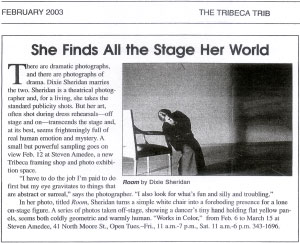
"I have to do the job I'm paid to do first but my eye gravitates to things that are abstract or surreal,'' says the photographer. "I also look for what's fun and silly and troubling."
In her photo, titled Room, Sheridan turns a simple white chair into a foreboding presence for a lone on-stage figure. A series of photos taken off-stage, showing a dancer's tiny hand holding flat yellow panels, seems both coldly geometric and warmly human. "Works in Color", from Feb. 6 to March 15 at Steven Amedee, 41 North Moore St., Open Tues.-Fri., 11 a.rn.-7 p.m.' Sat. 11 a.m.-6 p.m. 343-1696.
Photos deep in substance, scope
By Wayne LempkaPoughkeepsie Journal
Monday, June 12, 2000
Ex-valley resident featured at Vassar center
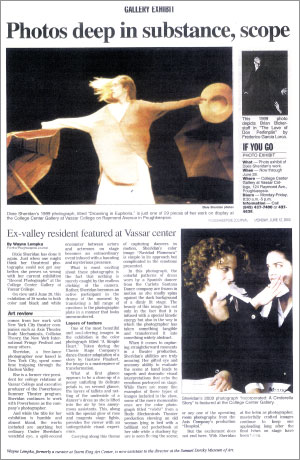
On view until June 28, this exhibition of 29 works in both color and black and white comes from her work with New York City theater companies such as Axis Theater, Rude Mechanicals, Collision Theory, the New York International Fringe Festival and many others.
Sheridan, a free-lance photographer now based in New York City, spent some time traipsing through the Hudson Valley.
She is a former vice president for college relations at Vassar College and executive producer of the Powerhouse Summer Theater program. Sheridan continues to work with Powerhouse as the company's photographer.
And while the title for her exhibition is humble and almost bland, the works included are anything but ordinary. Under Sheridan's watchful eye, a split-second encounter between actors and actresses on stage becomes an extraordinary event infused with a haunting and mysterious presence.
What is most exciting about these photographs is the fact that nothing is merely caught by the endless clicking of the camera. Rather, Sheridan becomes an active participant in the drama of the moment by translating a full range of emotions to the photographic plate in a manner that looks unencumbered.
Layers of texture
One of the most beautiful and soul-stirring images in the exhibition is the color photograph titled "A Simple Heart." Taken during the Classic Stage Company's dance-theater adaptation of a story by Gustave Flaubert, the image is a masterpiece of transformation.
What at first glance appears to be a close-up of a peony unfurling its delicate petals is, on second glance, the layers of taffeta and netting of the underside of a dancer's dress as she is lifted into the air by two anonymous assistants. This, along with the special glow of rose and magenta stage lights, provides the viewer with an unforgettable visual experience.
Carrying along this theme of capturing dancers in motion, Sheridan's color image "Navidad Flamenca" is simple in its approach but complicated in the emotions presented.
In this photograph the colorful patterns of dress worn by a Spanish dancer from the Carlota Santana Dance company are frozen in motion as she madly spins against the dark background of a dimly lit stage. The beauty of this image lies not only in the fact that it is infused with a special kinetic energy but also in the way in which the photographer has taken something tangible and transformed it into something widely abstract.
When it comes to capturing straightfoward moments in a theater production, Sheridan's abilities are truly amazing. Her gifted eye and uncanny ability to evaluate the scene at hand leads to superb and dramatic visual interpretations that echo the emotions portrayed on stage. While there are many fine examples of these types of images included is the show some of the more memorable ones are the color photograph titled "(wish)" from a Rude Mechanicals Theater production showing an old woman lying in bed with a brilliant red pocketbook at her side while a shadowy figure is seen fleeing the scene; or any one of the operating room photographs from the Axis Company's production "Hospital."
But the excitement does not end here. With Sheridan at the helm as photographer, masterfully crafted images continue to keep one applauding long after the final bows on stage have been taken.
Wayne Lempka, formerly a curator at Storm King Art Center, is now assistant to the director at the Samuel Dorsky Museum of Art.
Sheridan's 'Theater Photographs' take center stage at Vassar gallery
Wayne LempkaPoughkeepsie Journal
Art Review
Friday, June 6, 1997
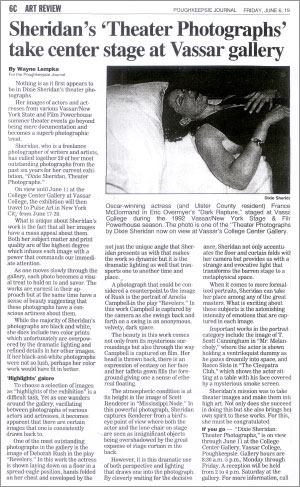
Her images of actors and actresses from various Vassar/New York State and Film Powerhouse summer theater events go beyond being mere documentation and becomes a superb photographic treat.
Sheridan who is a freelance photographer of writers and artists has culled together 29 of her most outstanding photographs from the past six years for her current exhibition "Dixie Sheridan Theater Photographs."
On view until June 11 at the College Center Gallery at Vassar College, the exhibition will then travel to Pulse Art in New York City from June 17-28.
What is unique about Sheridan's work is the fact that all her images have a mass appeal about them. Both her subject matter and print quality are of the highest degree which infuses each image with a power that commands our immediate attention.
As one moves slowly through the gallery, each photo becomes a visual treat to hold on to and savor. The works are earnest in their approach but at the same time have a sense of beauty suggesting that these photographs have a conscious artiness about them.
While the majority of Sheridan's photographs are black and white she does include two color prints which unfortunately are overpowered by the dramatic lighting and refined details in her other images. If her black-and-white photographs were not so lush, perhaps her color work would have fit in better.
'Highlights' galore
To choose a selection of images as "highlights of the exhibition" is a difficult task. Yet as one wanders around the gallery, vacillating between photographs of various actors and actresses, it becomes apparent that there are certain images that one is consistently drawn back to.
One of the most outstanding photographs in the gallery is the image of Deborah Rush in the play "Revelers." In this work the actress is shown laying down on a floor in a spread-eagle position, hands folded on her chest and enveloped by the black satin taffeta of her gown. It is not just the unique angle that Sheridan presents us with that makes the work so dynamic but it is the dramatic lighting as well that transports one to another time and place.
A photograph that could be considered a counterpoint to the image of Rush is the portrait of Amelia Campbell in the play "Revelers." In this work Campbell is captured by the camera as she swings back and forth on a swing in an anonymous, velvety, dark space.
The beauty in this work comes not only from its mysterious surroundings but also through the way Campbell is captured on film. Her head is thrown back, there is an expression of ecstasy on her face and her taffeta gown fills the foreground giving one a sense of ethereal floating.
The atmospheric condition is at its height in the image of Scott Renderer in "Mississippi Nude." In this powerful photograph, Sheridan captures Renderer from a bird's-eye point of view where both the actor and the lone chair on stage are seen as insignificant objects being overshadowed by the great expanse of stage curtain in the back.
However, it is this dramatic use of both perspective and lighting that draws one into the photograph. By cleverly waiting for the decisive moment when everything is in balance, Sheridan not only accentuates the floor and curtain folds with her camera but provides us with a strange and evocative light that transforms the barren stage to a metaphysical space.
When it comes to more formalized portraits, Sheridan can take her place among any of the great masters. What is exciting about these subjects is the astonishing intensity of emotions that are captured in each image.
Important works in the portrait category include the image of T. Scott Cunningham in "Mr. Melancholy," where the actor is shown holding a ventriloquist dummy as he gazes dreamily into space, and Rocco Sisto in "The Cleopatra Club," which shows the actor sitting at a table with his face covered by a mysterious smoke screen.
Sheridan's mission was to take theater images and make them into high art. Not only does she succeed in doing this but she also brings her own spirit to these works. For this she must be congratulated.
Wayne Lempka is the curator of education at Storm King Art Center.
Photo play
Time Out New YorkJune 19-26, 1997
Issue 91

It's tough enough to capture elusive moments on celluloid, much less to freeze frame a performance on the stage. But Dixie Sheridan's photographs of actors and playwrights have an isolated, haunting quality that relay some of the magic that takes place in the spotlights. Taken over a period of five years at the Vassar New York Stage and Film Powerhouse series in Poughkeepsie, the mostly black-and-white photographs on display include glimpses of Jon Robin Baitz, Steve Martin, John Patrick Shanley, Eric Overmyer, Frances McDormand and Beth Henley.
"Dixie Sheridan/Theater Photographs" is at Pulse Art, 494 Broadway between Spring and Broome Streets.
Dixie Sheridan's Stage Photographs
Rich O'CorozineWoodstock Times
June 15, 2000
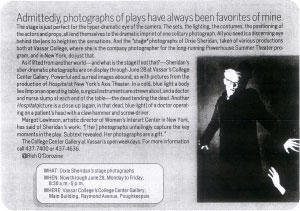
As if lifted from another world–and what is the stage if not that?–Sheridan's uber-dramatic photographs are on display through June 28 at Vassar's College Center Gallery. Powerful and surreal images abound, as with pictures from the production of "Hospital" at New York's Axis Theater. In a cold blue light a body lies limp on an operating table, surgical instruments are strewn about, and a doctor and nurse slump at each end of the table–the dead tending the dead. Another Hospital picture is a close-up (again, in that dead, blue light) of a doctor operating on a patient's head with a claw-hammer and screw-driver.
Margot Lewinson, artistic director of Women's Interart Center in New York, has said of Sheridan's work: [Her] photographs unfailingly capture the key moments in the play. Subtext revealed. Her photographs are a gift.'